Ancient shrines of Kyiv. Continuation
After examining the Church of the Savior on Berestov, which has just been opened after restoration (beginning here), I hasten to the territory of the Lavra.
The next "target" is the Big Lavra Bell Tower. When I visit different European cities, I always climb the bell tower, the dome of the cathedral or some kind of observation deck, from where you can see the roofs of houses, distant streets and even the outskirts of the city. Well, how without these magnificent views, which are breathtaking and dizzy? ; )
 View from the belfry of the Kiev Pechersk Lavra
View from the belfry of the Kiev Pechersk Lavra
 View from the belfry of the Kiev-Pechersk Lavra. On the right– The Church of All Saints, and behind it, a little to the left, with green domes, the Savior on Berestovo
View from the belfry of the Kiev-Pechersk Lavra. On the right– The Church of All Saints, and behind it, a little to the left, with green domes, the Savior on Berestovo
 View from the belfry of the Kiev-Pechersk Lavra. Church of All Saints
View from the belfry of the Kiev-Pechersk Lavra. Church of All Saints
 View from the belfry of the Kiev Pechersk Lavra
View from the belfry of the Kiev Pechersk Lavra
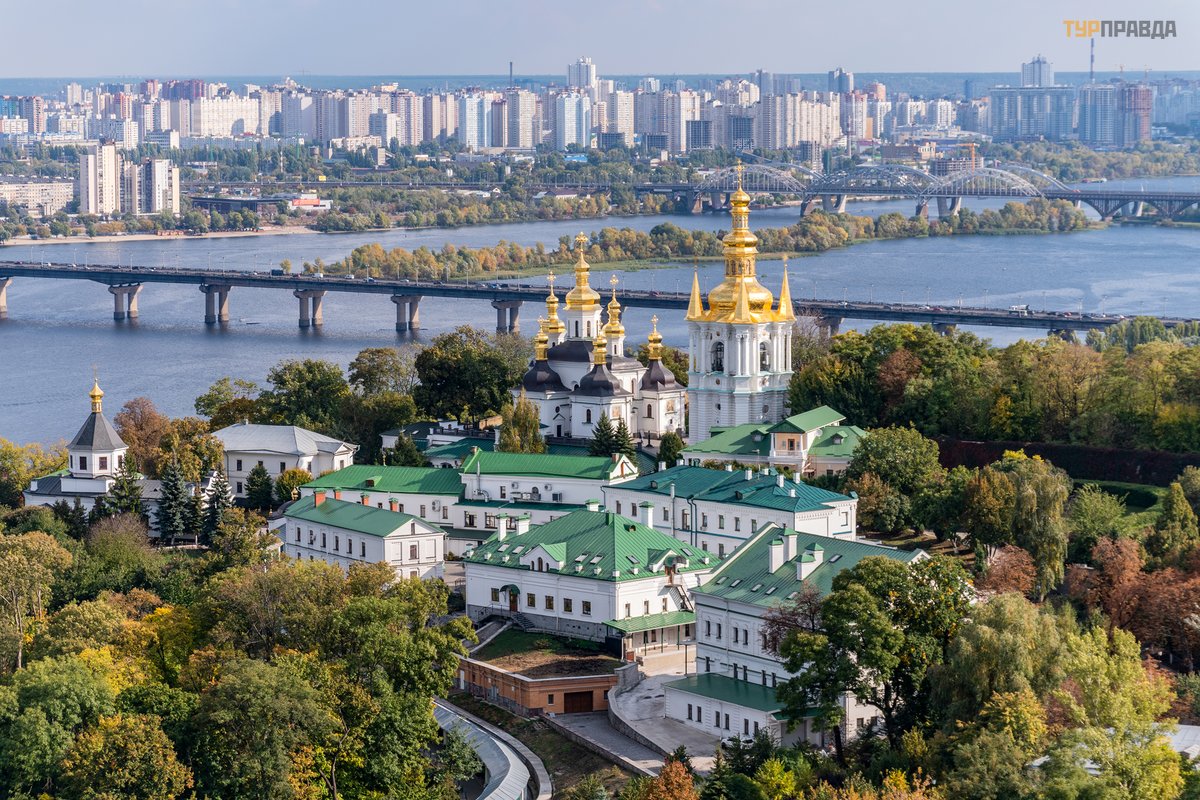 View from the belfry of the Kiev Pechersk Lavra
View from the belfry of the Kiev Pechersk Lavra
Until the 18th century, the bell towers in the Kiev-Pechersk Lavra were wooden. Hetman Ivan Mazepa donated to the new stone funds. The foundation was laid in 1707, but due to the death of the architect, the construction of the bell tower had to be curtailed. In 1718, the wooden buildings of the Lavra burned down in a fire, and then it was decided to return to the construction of a stone bell tower.
The Great Lavra Bell Tower was erected in 1731-1745 according to the project of the architect Johann Gottfried Schedel. The construction took 5 million bricks of different sizes and shapes.
The height of the bell tower with a cross is 96.5 meters, it consists of 4 tiers, each tier had its own design and purpose: the first one housed the archive of the Kiev-Pechersk Lavra, the second one - the library, the third one - the bell tower, and the fourth one - the clock -chimes. The thickness of the walls in the lower part is 8 m. The bell tower deviates from the vertical by 62 cm, but, they say, the slope has not changed over the years. To climb up, you need to overcome 374 steps.
On the threshold of the bell tower, I asked the attendant how many steps to go. I heard 174.
Total? Yes, after the Asinelli tower in Bologna, 498 steps (I visited it a month ago), climb our beautiful large bell tower - “what is there to climb! ”. Moreover, the steps are wide, two people can easily miss each other. And window openings along the road. But. . . I stopped twice to catch my breath. It turns out that I actually climbed 374 steps. Well, almost like Asinelli! : )
I climb to the topmost tier available for inspection. There are 15 bells hanging here.
The eye immediately clings to the large bell with animal heads on the dome. It turns out that this is the largest bell of the Lavra bell tower - the bell of All Saints, donated to the Kiev-Pechersk Lavra by Donetsk metallurgists in 2005. This is the first bell on which the text of the prayer and all memorial inscriptions are made in Ukrainian. And the figures at the top that attracted me are the symbolic image of the evangelists in the form of an angel, a calf, an eagle and a lion. The bell stood for 10 years on the ground at the foot, and only in 2014, on the day of the Transfiguration of the Lord, it was raised and installed on the bell tower.
 Kiev-Pechersk Lavra. Bell of All Saints
Kiev-Pechersk Lavra. Bell of All Saints
 Kiev-Pechersk Lavra. Bell of All Saints
Kiev-Pechersk Lavra. Bell of All Saints
 Kiev-Pechersk Lavra. Bell of All Saints
Kiev-Pechersk Lavra. Bell of All Saints
Of the ancient ones that have survived to this day, there is a 400-year-old bell "Balyk": "From Sozont Balyk, mayor of Kiev, formerly in 1613 to the Pechersky Monastery of Kyiv, nadan and named Balyk". And the thousand-pound "Assumption" bell, which was cast in 1732 by the Russian master Ivan Motorin, the author of the Kremlin Tsar Bell.
The staircase leads even higher - to the fourth tier with a clock, but it is closed with wrought iron bars.
Having studied the views of my native city (I confess, I did not like all of them), I go down a little lower - to the balcony encircling the bell tower. Directly opposite - the domes of the Assumption Cathedral.
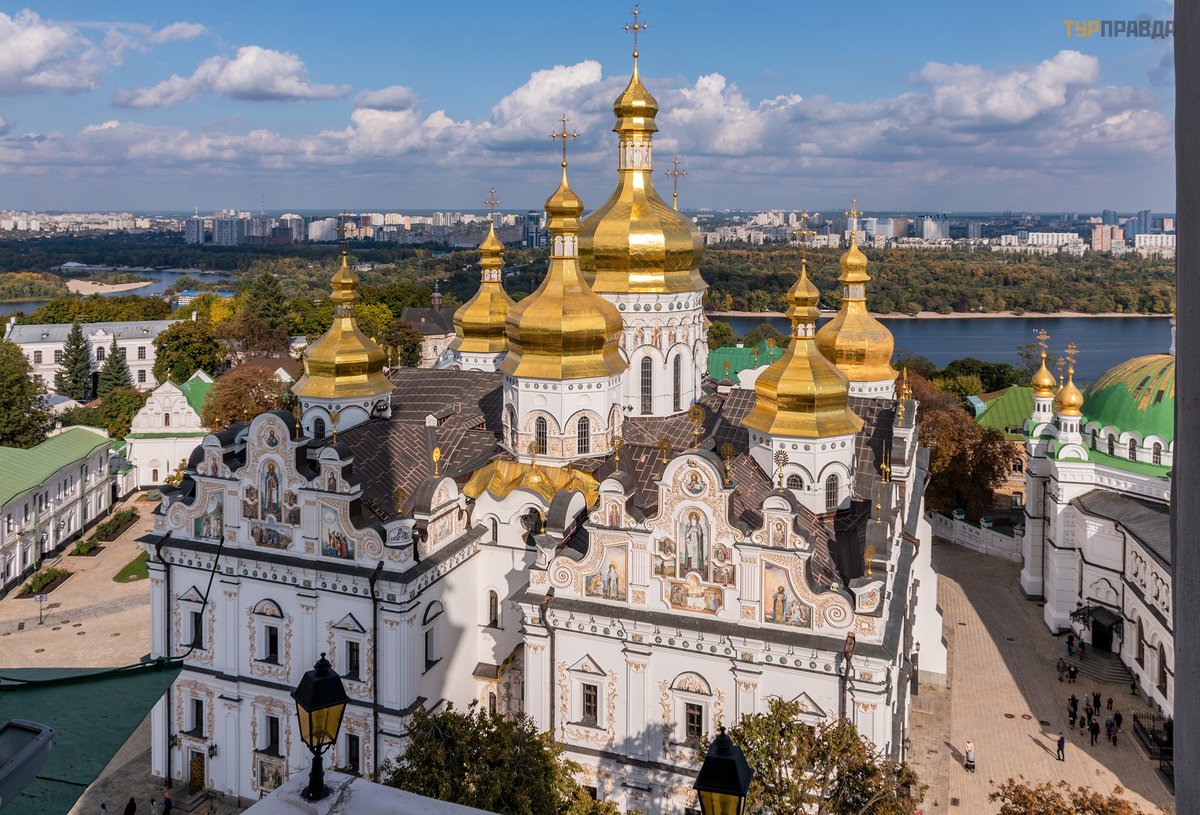 Kiev-Pechersk Lavra. Assumption Cathedral
Kiev-Pechersk Lavra. Assumption Cathedral
And you can see the faces of the saints on the pediment and drums of the domes.
 Kiev-Pechersk Lavra. Assumption Cathedral
Kiev-Pechersk Lavra. Assumption Cathedral
 Kiev-Pechersk Lavra. Assumption Cathedral
Kiev-Pechersk Lavra. Assumption Cathedral
Suddenly I notice that a figurine of a bird "sits" on the cross of the central dome. Unfortunately, I have not found an explanation for this symbol anywhere.
 Kiev-Pechersk Lavra. Assumption Cathedral
Kiev-Pechersk Lavra. Assumption Cathedral
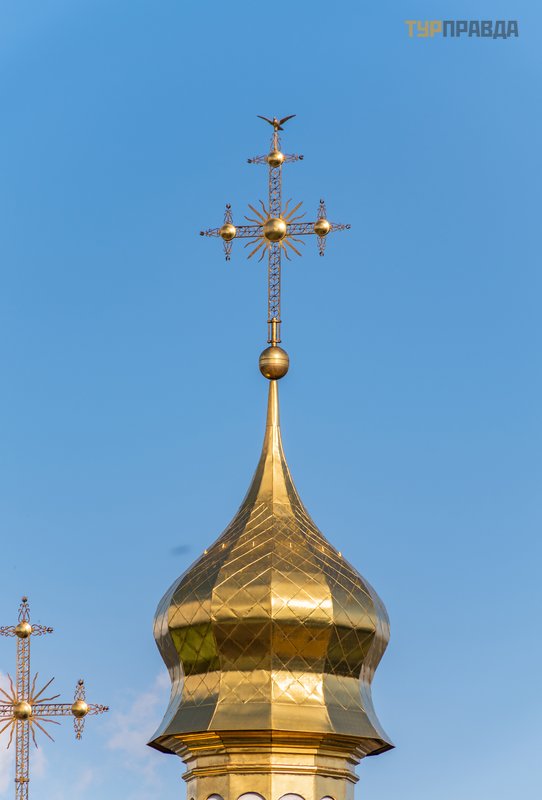 Kiev-Pechersk Lavra. Assumption Cathedral
Kiev-Pechersk Lavra. Assumption Cathedral
To the right of the Assumption Cathedral is the Church of St. Anthony and Theodosius of the Caves, also known as the Refectory Church. The temple is active, admission is free. Every time I get to the territory of the Lavra, I am drawn to go to this church. I really like its interior decoration. She also has incredible energy, she just wants to sit on a bench, take a break and not think about anything.
 Kiev-Pechersk Lavra. Refectory Church
Kiev-Pechersk Lavra. Refectory Church
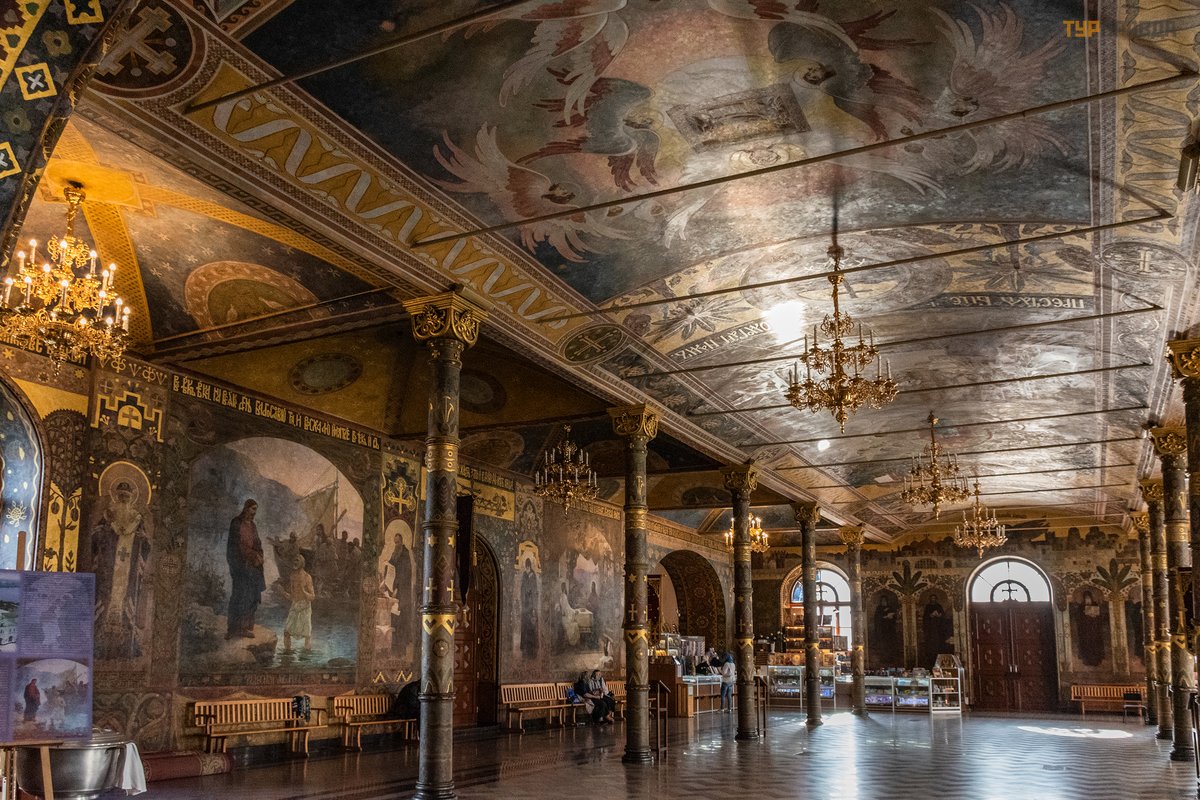 Kiev-Pechersk Lavra. Refectory
Kiev-Pechersk Lavra. Refectory
 Kiev-Pechersk Lavra. Refectory
Kiev-Pechersk Lavra. Refectory
The first monastery refectory was built in 1108, but during the earthquake of 1230 it was badly damaged. This is all that has been preserved about her in the annals. In 1684-1694. at the expense of the Kiev tradesman Mikhail Maksimovich, a new refectory was built in the Lavra - a stone one. Almost 30 years later, it was decorated with wall paintings, and a century and a half later, in 1862, a second floor was built over the chamber with living quarters for novices who worked in the fraternal refectory and kitchen.
But, obviously, new times brought new trends not only to worldly life, but also to monastic life. In the summer of 1893, the Spiritual Cathedral decided to dismantle the old building. The new Refectory with an attached church - the one we see now - was designed by the famous architect Vladimir Nikolaev, the author of many Kiev buildings, in particular the Chocolate House, the Lieberman Mansion, the building of the Museum of Russian Art and many, many others.
A new church was consecrated in the name of Saints Anthony and Theodosius on August 13.1895
At the wall of the Refectory Church is the grave of the prime minister of the tsarist government, Pyotr Stolypin, who was shot dead in Kyiv in 1911.
Photographs are not allowed inside the church. As in other buildings of the Kiev-Pechersk Lavra. But when I entered, a wedding group led by a photographer was standing in the background of the altar. And I decided to quietly take advantage of the situation. . . ; )
 Kiev-Pechersk Lavra. Refectory Church
Kiev-Pechersk Lavra. Refectory Church
 Kiev-Pechersk Lavra. Refectory Church
Kiev-Pechersk Lavra. Refectory Church
 Kiev-Pechersk Lavra. Refectory Church
Kiev-Pechersk Lavra. Refectory Church
 Kiev-Pechersk Lavra. Refectory Church
Kiev-Pechersk Lavra. Refectory Church
 Refectory Church. Fresco "Feeding five thousand people with five loaves"
Refectory Church. Fresco "Feeding five thousand people with five loaves"
 Kiev-Pechersk Lavra. Refectory Church
Kiev-Pechersk Lavra. Refectory Church
 Kiev-Pechersk Lavra. Refectory Church
Kiev-Pechersk Lavra. Refectory Church
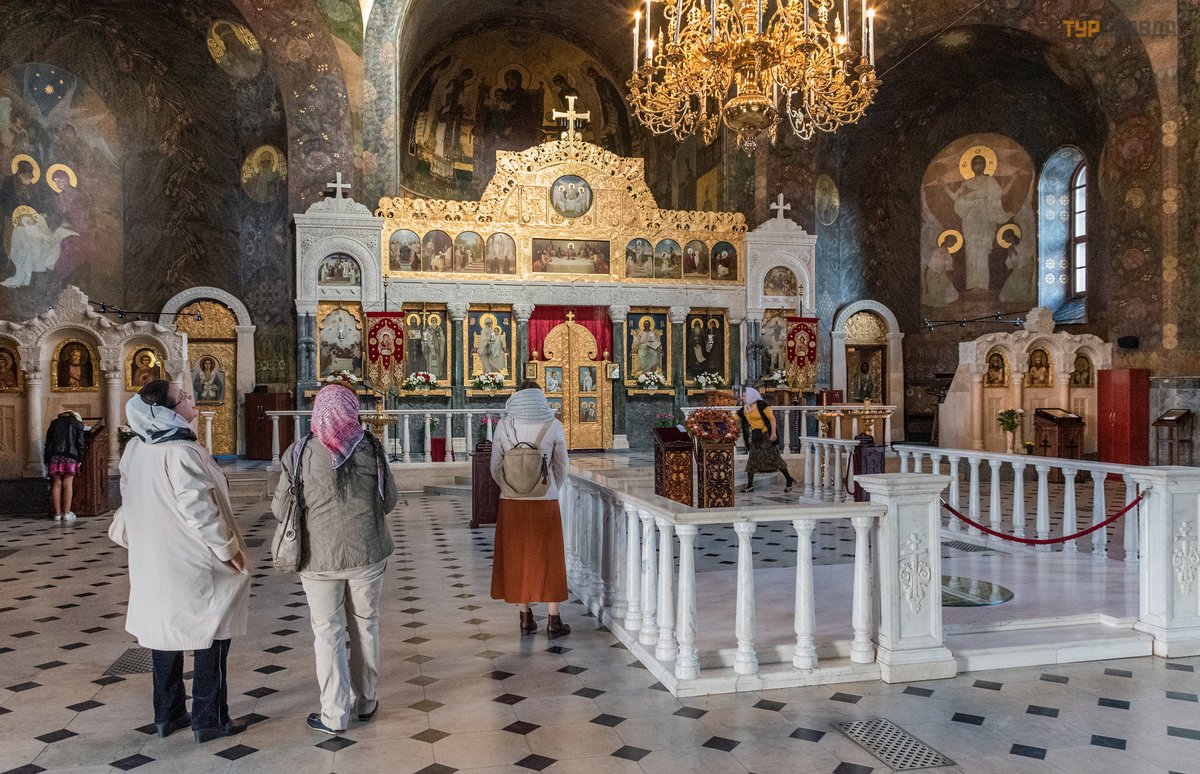 Kiev-Pechersk Lavra. Refectory Church
Kiev-Pechersk Lavra. Refectory Church
I took a few pictures, I look up, and a nun in a black robe is rapidly moving towards me. Well, I think that's all - either the camera will now take away, or a reprimand will suit. She had such an expression on her face. . . : ) I quickly lowered the camera, took a step to the side. . . It turned out that I was standing with my back to the cross with the image of Christ, and the nun was going to venerate him with her lips.
A poster announcing the exhibition dedicated to the birthday of Ivan Mazepa near the Assumption Cathedral.
Religious objects belonging to the hetman's family and donated by them to the Kiev-Pechersk Lavra were exhibited in a small exhibition hall at the cathedral.
It was the Pechersk Lavra that was under the special care of Ivan Mazepa. With his money, defensive walls were erected around the Upper Lavra, the Church of All Saints was built, the Great Assumption and Trinity Gate Churches were restored.
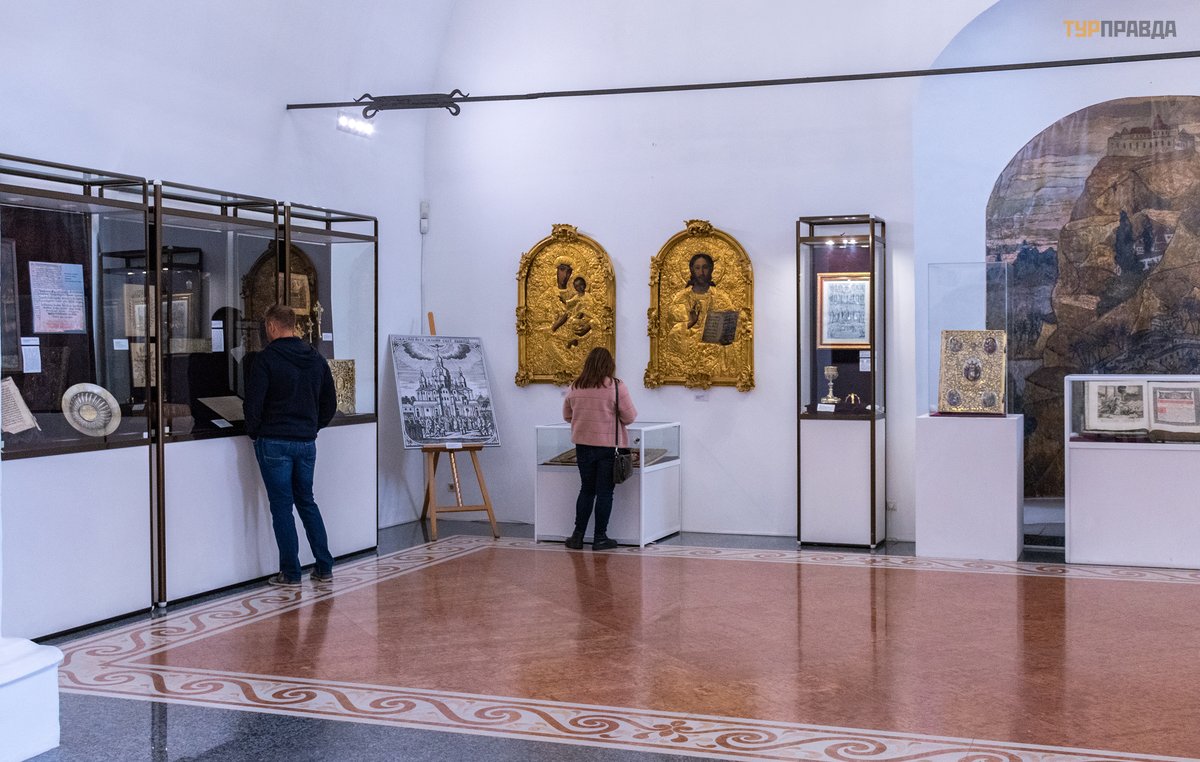 Exhibition of gifts from the family of Hetman Mazepa to the Kiev Pechersk Lavra
Exhibition of gifts from the family of Hetman Mazepa to the Kiev Pechersk Lavra
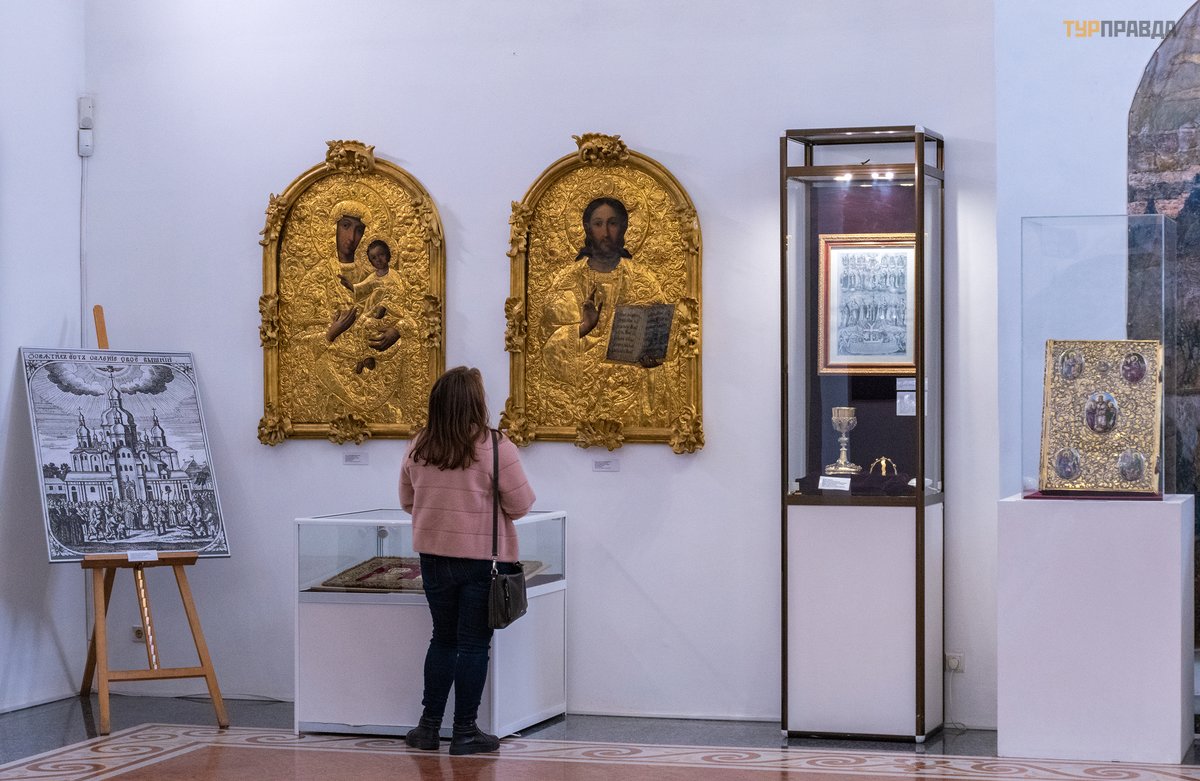 Exhibition of gifts from the family of Hetman Mazepa to the Kiev Pechersk Lavra
Exhibition of gifts from the family of Hetman Mazepa to the Kiev Pechersk Lavra
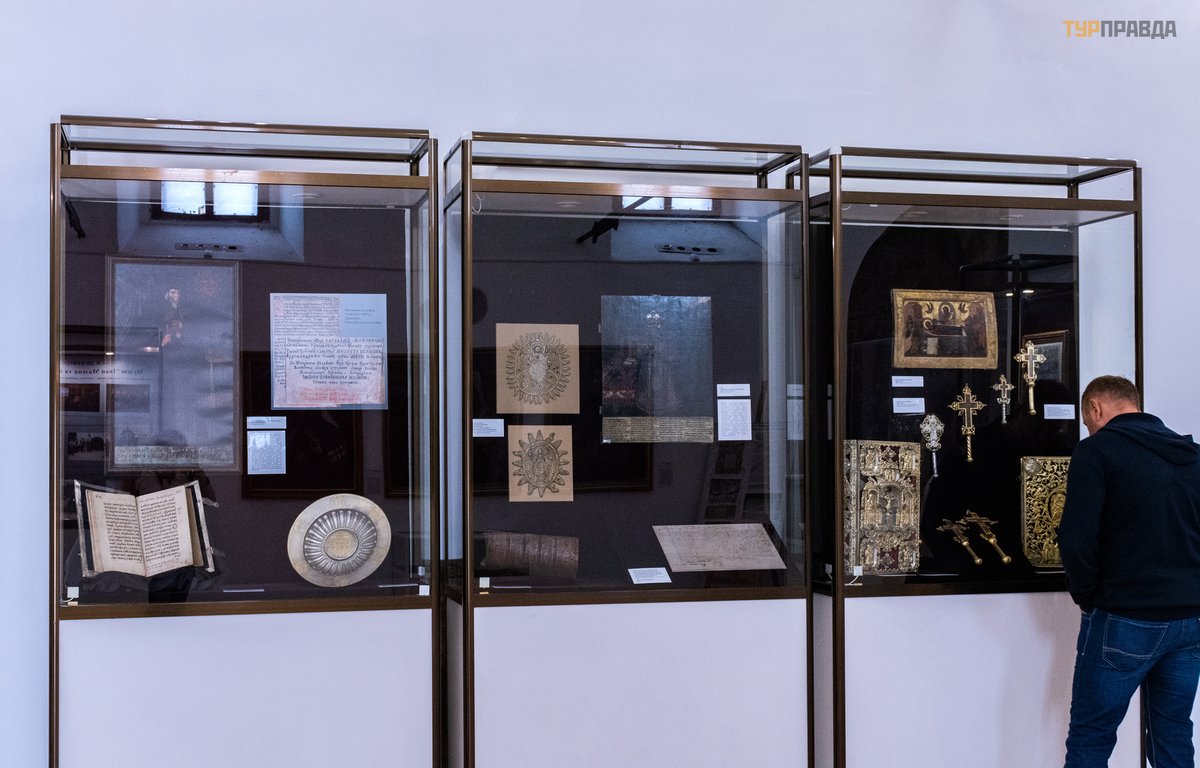 Exhibition of gifts from the family of Hetman Mazepa to the Kiev Pechersk Lavra
Exhibition of gifts from the family of Hetman Mazepa to the Kiev Pechersk Lavra
The bedspreads embroidered with gold and silver threads were created in the gold embroidery workshops of the Kiev-Pechersk Ascension Convent during the years when Mary Magdalene Mazepa, the hetman's mother, was the abbess there.
 Exhibition of gifts from the family of Hetman Mazepa to the Pechersk Lavra. Air (liturgical cloth)
Exhibition of gifts from the family of Hetman Mazepa to the Pechersk Lavra. Air (liturgical cloth)
The gospels lying under glass were accompanied by the inscription "From the sacristy of the Assumption Cathedral".
 Exhibition of gifts from the family of Hetman Mazepa to the Kiev Pechersk Lavra. Gospel
Exhibition of gifts from the family of Hetman Mazepa to the Kiev Pechersk Lavra. Gospel
Knowing the sad fate of the main Lavra church, I asked a museum employee: “Where from? How did they survive?
“A lot of church utensils were found under the rubble, ” she replied and advised to definitely see the exhibition “The Restored Treasures of the Kiev-Pechersk Lavra. ”
With generous permission, I take a few pictures and go to see the miraculously preserved ancient attributes of Orthodoxy.
I couldn't take pictures anywhere else, so the photos below are from the site National Kiev-Pechersk Historical and Cultural Reserve and other sites. I scooped up historical facts there.

In several halls, items of the 15th-20th centuries from the stock collection of the National Reserve are displayed: icons, silver and gold church utensils, liturgical fabrics, embroideries, early printed books, engravings, and sculpture. Many were found during excavations of the Assumption Cathedral, which was blown up in 1941, and which had lain under its ruins for five years.
They were carefully collected, stored, and now they are being rescued using modern techniques, while trying to minimally interfere with the authenticity of the relic.
For example, a phelonion of 1750, made in the Florovsky Monastery in Kiev. On the shoulder part of the liturgical vestment are the images of St. Prince Vladimir, Princess Olga, Princes Boris and Gleb.

One of the pearls of the collection and at the same time the most ancient exhibit is the Shroud of 1561
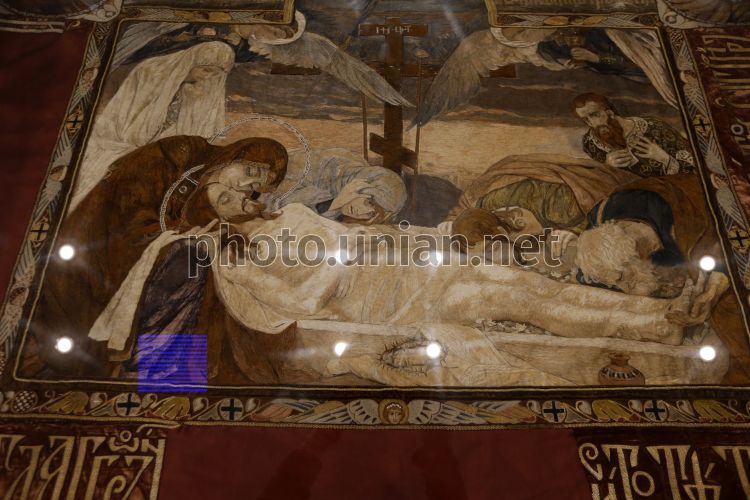
Next to each object, there is a stand with several photographs: one shows the form in which the relic was found, next - how it looks after restoration, as well as pictures of different stages of restoration work. The ingenious, painstaking work of our restorers, preserving unique rarities!
I ended my walk at the Trinity Gate Church, towering over the main Lavra entrance - the Holy Gates. This is the oldest church of the Lavra, built back in the 12th century, and survived all subsequent centuries almost unchanged.
 Kiev-Pechersk Lavra. Trinity Gate Church
Kiev-Pechersk Lavra. Trinity Gate Church
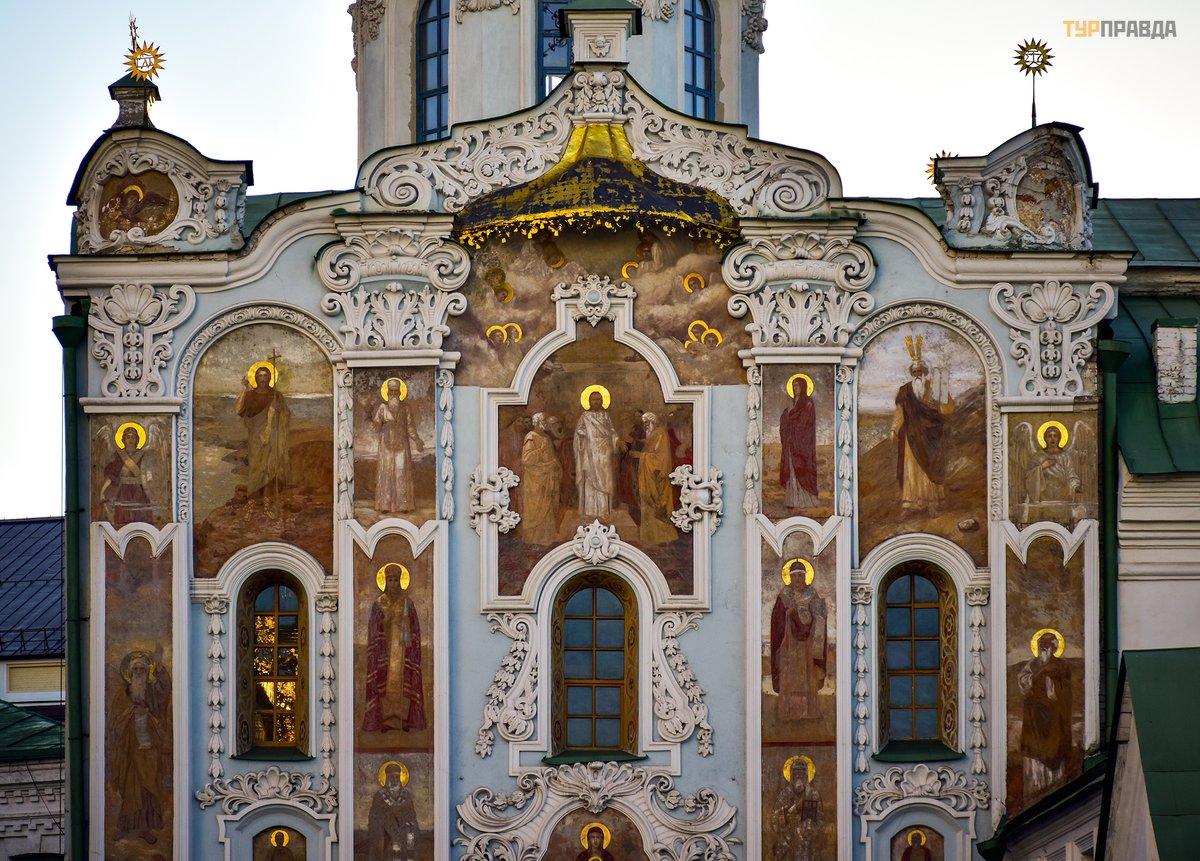 Kiev-Pechersk Lavra. Trinity Gate Church
Kiev-Pechersk Lavra. Trinity Gate Church
The church was built in 1106-1108. at the expense of Prince Svyatoslav Davidovich of Chernigov, who was tonsured in the Kiev Caves Monastery under the name of Nikola Svyatoshi.
The peculiarity of the church is its small size, only 10x8.9 m, and you can get into it by the steps leading to the upper tier. There are no choirs in the church, and in ancient times there was no vestibule - it was completed in the first half of the 17th century. In 1732, a carved gilded wooden iconostasis appeared - it is considered one of the best surviving Ukrainian iconostases. It is made of linden using the technique of “through carving”, crowns the iconostasis of the arch with the inscription “These are the gates of the Lord. The righteous will enter into them. ”
Starting from the entrance, the walls along the steps and the entire church are decorated with magnificent paintings. Along the wall of the temple there is a row of wooden stasidia benches intended for the elderly and sick monks of the St. Nicholas Hospital Monastery. The backs of stasidia are also decorated with drawings.
The frescoes have darkened with time, the gloomy staircase leading to the tiny church premises - there is a feeling of deep antiquity.
The duty officer, seeing the camera in my hands, repeated several times that it was impossible to take pictures here. : ( And since my camera makes treacherous clicks, I didn't try. : )
Now the church building is going to be restored (outside, everything is covered with scaffolding and construction mesh), which means that there is hope that the interior of this ancient building will soon be updated.
When I was leaving, my family rose to meet me - my father pointed them to the plot on the wall above the stairs with the words: "Pay attention to this monk - in whatever direction you move, his eyes follow you. " Unfortunately, I was already standing at the exit and could not check, but if someone gets inside the gate church, pay attention to this monk. The fresco is located on the left, almost at the top step of the stairs.

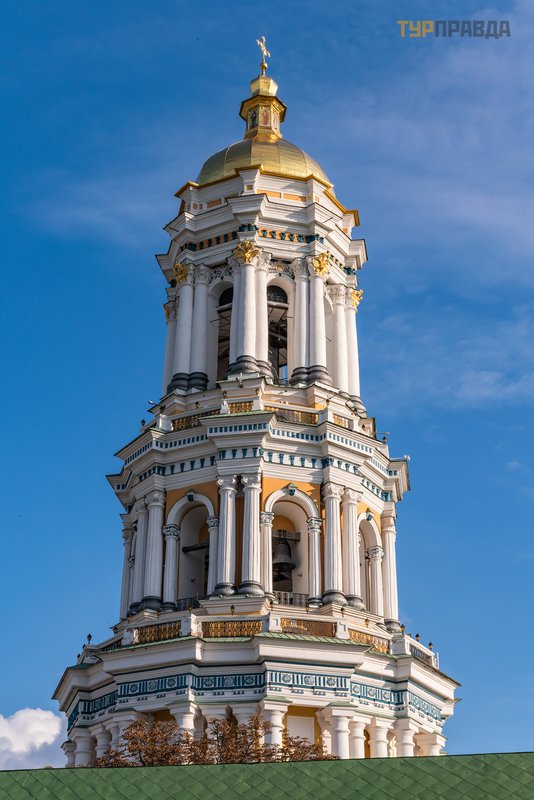
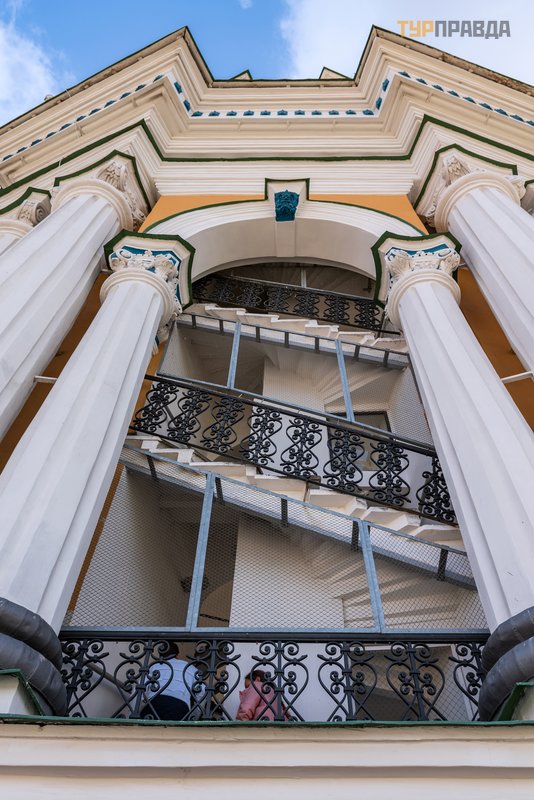


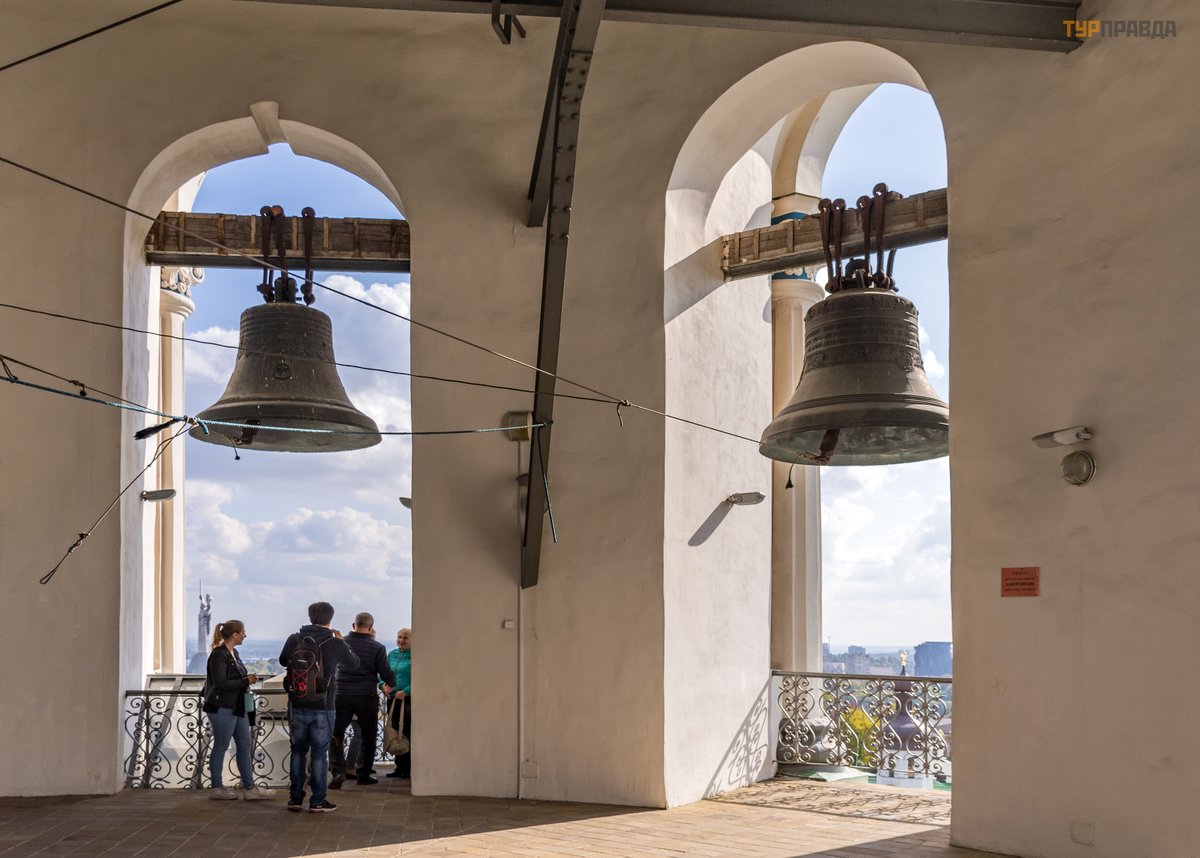


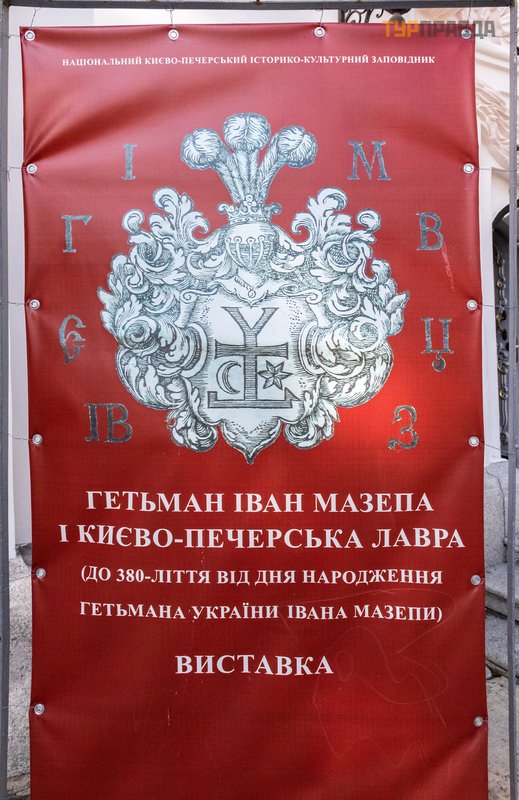













































Great review!!!
Прекрасный обзор!!!
Lena, the bird on the cross is a dove, a symbol of the Holy Spirit. I guessed it myself, but just in case, I googled and found confirmation here
https://fakty.ua/ru/353385-sudya-po-razrusheniyam-uspenskij-sobor-v-kieve-unichtozhili-sovetskie-podryvniki-kak-vosstanavlivali-svyatynyu
Лена, птичка на кресте - голубь, символ Святого Духа. Я догадалась сама, но на всякий случай погуглила и нашла подтверждение здесь
https://fakty.ua/ru/353385-sudya-po-razrusheniyam-uspenskij-sobor-v-kieve-unichtozhili-sovetskie-podryvniki-kak-vosstanavlivali-svyatynyu
Lena, the bird on the cross is a dove, a symbol of the Holy Spirit. I guessed it myself, but just in case, I googled and found confirmation here
https://fakty.ua/ru/353385-sudya-po-razrusheniyam-uspenskij-sobor-v-kieve-unichtozhili-sovetskie-podryvniki-kak-vosstanavlivali-svyatynyu
Лена, птичка на кресте - голубь, символ Святого Духа. Я догадалась сама, но на всякий случай погуглила и нашла подтверждение здесь
https://fakty.ua/ru/353385-sudya-po-razrusheniyam-uspenskij-sobor-v-kieve-unichtozhili-sovetskie-podryvniki-kak-vosstanavlivali-svyatynyu
Ira, thanks. And thanks for the article.
At the same time, I read there about the lost and stolen rarities of our Ukrainian cathedrals.
Ира, спасибо. И спасибо за статью.
Заодно и прочитала там об утраченных и украденных раритетах наших, украинских, соборов.
Ira, thanks. And thanks for the article.
At the same time, I read there about the lost and stolen rarities of our Ukrainian cathedrals.
Ира, спасибо. И спасибо за статью.
Заодно и прочитала там об утраченных и украденных раритетах наших, украинских, соборов.